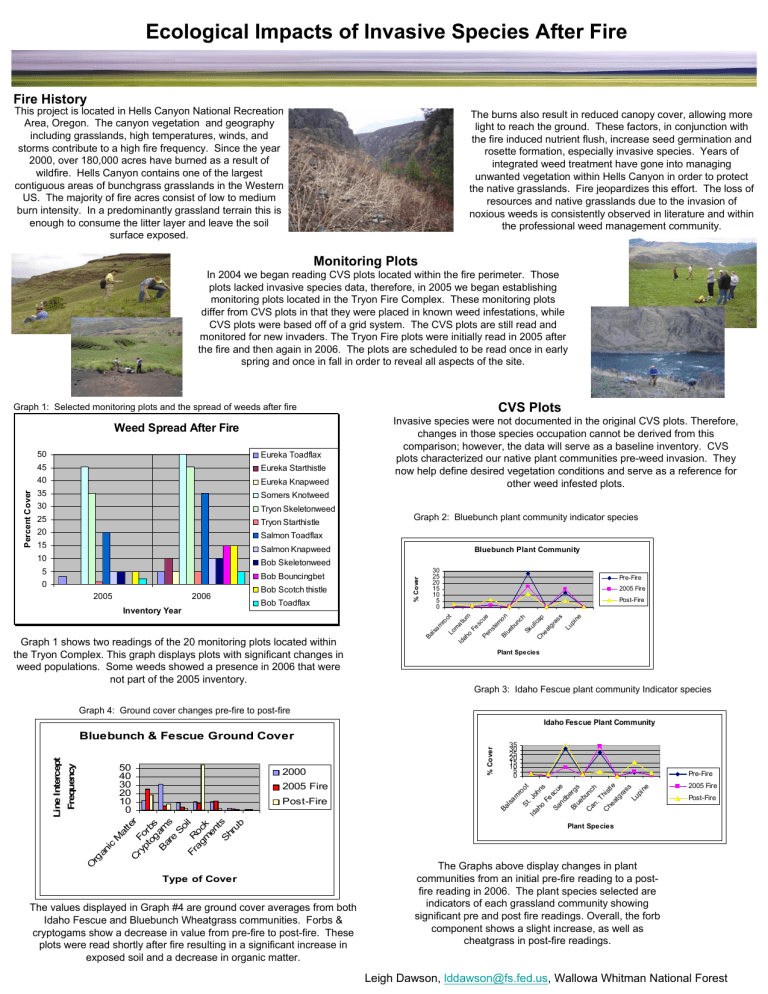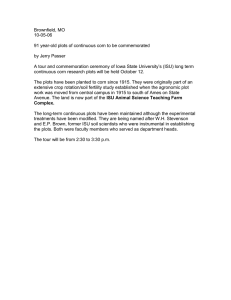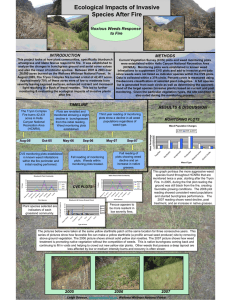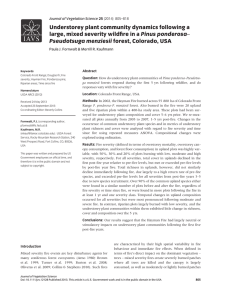Ecological Impacts of Invasive Species After Fire Fire History

Ecological Impacts of Invasive Species After Fire
Fire History
This project is located in Hells Canyon National Recreation
Area, Oregon. The canyon vegetation and geography including grasslands, high temperatures, winds, and storms contribute to a high fire frequency. Since the year
2000, over 180,000 acres have burned as a result of wildfire. Hells Canyon contains one of the largest contiguous areas of bunchgrass grasslands in the Western
US. The majority of fire acres consist of low to medium burn intensity. In a predominantly grassland terrain this is enough to consume the litter layer and leave the soil surface exposed.
The burns also result in reduced canopy cover, allowing more light to reach the ground. These factors, in conjunction with the fire induced nutrient flush, increase seed germination and rosette formation, especially invasive species. Years of integrated weed treatment have gone into managing unwanted vegetation within Hells Canyon in order to protect the native grasslands. Fire jeopardizes this effort. The loss of resources and native grasslands due to the invasion of noxious weeds is consistently observed in literature and within the professional weed management community.
Monitoring Plots
In 2004 we began reading CVS plots located within the fire perimeter. Those plots lacked invasive species data, therefore, in 2005 we began establishing monitoring plots located in the Tryon Fire Complex. These monitoring plots differ from CVS plots in that they were placed in known weed infestations, while
CVS plots were based off of a grid system. The CVS plots are still read and monitored for new invaders. The Tryon Fire plots were initially read in 2005 after the fire and then again in 2006. The plots are scheduled to be read once in early spring and once in fall in order to reveal all aspects of the site.
Graph 1: Selected monitoring plots and the spread of weeds after fire
Weed Spread After Fire
30
25
20
15
10
5
0
50
45
40
35
2005
Inventory Year
2006
Eureka Toadflax
Eureka Starthistle
Eureka Knapweed
Somers Knotweed
Tryon Skeletonweed
Tryon Starthistle
Salmon Toadflax
Salmon Knapweed
Bob Skeletonweed
Bob Bouncingbet
Bob Scotch thistle
Bob Toadflax
CVS Plots
Invasive species were not documented in the original CVS plots. Therefore, changes in those species occupation cannot be derived from this comparison; however, the data will serve as a baseline inventory. CVS plots characterized our native plant communities pre-weed invasion. They now help define desired vegetation conditions and serve as a reference for other weed infested plots.
Graph 2: Bluebunch plant community indicator species
Bluebunch Plant Community
30
25
20
15
10
5
0
Ba ls am ro ot
Lom at iu m
Ida ho
Fe sc ue
Pe ns te m on
Bl ue bun ch
Sk ull ca p
C hea tgr as s
Plant Species
Lu pin e
Pre-Fire
2005 Fire
Post-Fire
Graph 1 shows two readings of the 20 monitoring plots located within the Tryon Complex. This graph displays plots with significant changes in weed populations. Some weeds showed a presence in 2006 that were not part of the 2005 inventory.
Graph 3: Idaho Fescue plant community Indicator species
Graph 4: Ground cover changes pre-fire to post-fire
Bluebunch & Fescue Ground Cover
50
40
30
20
10
0
Or g ani c M at te r
Cr
Fo rb s ypt og ams
B ar e
S oi l ck
Ro gmen
Fr a ts
S hr u b
Type of Cover
2000
2005 Fire
Post-Fire
Idaho Fescue Plant Community
35
25
15
10
Ba ls am ro ot
St. J ohns
F
Idaho es cue
Sa ndber gs
Bl ueb unc
C h an. T hi stl e
C heatg ras s
Lupi ne
Plant Species
Pre-Fire
2005 Fire
Post-Fire
The values displayed in Graph #4 are ground cover averages from both
Idaho Fescue and Bluebunch Wheatgrass communities. Forbs & cryptogams show a decrease in value from pre-fire to post-fire. These plots were read shortly after fire resulting in a significant increase in exposed soil and a decrease in organic matter.
The Graphs above display changes in plant communities from an initial pre-fire reading to a postfire reading in 2006. The plant species selected are indicators of each grassland community showing significant pre and post fire readings. Overall, the forb component shows a slight increase, as well as cheatgrass in post-fire readings.









